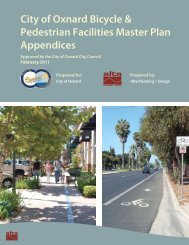View File - Development Services - City of Oxnard
View File - Development Services - City of Oxnard
View File - Development Services - City of Oxnard
You also want an ePaper? Increase the reach of your titles
YUMPU automatically turns print PDFs into web optimized ePapers that Google loves.
WATER RESOURCES TECHNICAL REPORTregister wells and report groundwater extractions on a semiannual basis. These ordinanceshave been superceded by Ordinance No. 8 adopted in 2002.The model grid is shown in Figure 5-1 and was constructed with 60 rows and 100 columnswith square cells, each 0.5-mile on a side. The model grid consists <strong>of</strong> two layers,representing the UAS and LAS, and is oriented at N. 27°W. The top layer excludes the semiperchedaquifer. The model encompasses the <strong>of</strong>fshore extent <strong>of</strong> the aquifer units. The upperlayer (UAS) is an active flow region covering 374 square meters (m 2 ) , <strong>of</strong> whichapproximately 27 percent is <strong>of</strong>fshore. The lower layer (LAS) is an active flow region <strong>of</strong>464 mi 2 , <strong>of</strong> which approximately 41 percent is <strong>of</strong>fshore.The model was used to simulate the 103-year period from 1891 through 1993. Thesimulation <strong>of</strong> groundwater and surface water flow was temporally discritized into 3-monthstress periods that represent the four seasons within a calendar year. Each season wasdiscritized into 12 equal time steps to estimate flow and heads throughout the model.Calibration <strong>of</strong> the transient state simulation was based on matching water levels and streamflows. Predevelopment conditions (steady-state) were used as the initial conditions for thetransient state calibration. The long period <strong>of</strong> transient simulation was necessary becausefeatures <strong>of</strong> development, such as coastal landward flow (seawater intrusion) andsubsidence, are dependent on the initial state <strong>of</strong> the aquifer systems. Calibration wasachieved through trial-and-error adjustments to recharge, hydraulic properties, andpumpage to achieve a good fit within each subarea <strong>of</strong> the historical period <strong>of</strong> record.Stream flow infiltration was calculated using measured and estimated stream flow and thestream flow-routine component <strong>of</strong> the groundwater flow model. Stream flow routingrequired construction <strong>of</strong> stream flow records for the major rivers and tributaries in the basinfor 1891 to the period <strong>of</strong> continuous gauged stream flow record. Stream flow was estimatedusing regression equations with seasonal precipitation for wet and dry climatic periods.5.1.2 Water Supply Project SimulationsModel simulations were performed to assess the effects <strong>of</strong> increased recharge, reducedpumpage, and shifted pumpage (from LAS to UAS) on groundwater storage depletion andrelated coastal landward flow and land subsidence. The primary approach used to projectfuture groundwater flow conditions to evaluate future water supply projects was tosimulate the 24-year period from 1994 to 2017 by repeating the historical inflow conditionsfor 1970 to 1993. This historical period cycles through a combination <strong>of</strong> 13 dry years and11 wet years and captures the variation <strong>of</strong> recent climate, recharge, and stream flow througha complete long-term wet/dry period. An alternate approach was also used to project futuregroundwater flow conditions by simulating recharge, stream flow, and climate-relateddemand based on spectral estimates <strong>of</strong> future precipitation. A 44-year simulation periodwas used for this alternate approach, which consisted <strong>of</strong> 21 wet years and 23 dry years thatrepresented two decadal cycles <strong>of</strong> climate variability.The simulations for both projection approaches included adjusting average groundwaterpumpage on a well-by-well basis for the period <strong>of</strong> reported pumping (1984-1993),estimating irrigation return flow from the 1969 land use distribution, and varying rechargeand stream flow climatically. Average pumpage and irrigation return flows were adjustedW112003002SCO LW1458.DOC/ 033390002 67
















